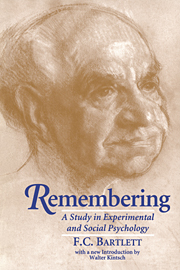Book contents
- Frontmatter
- Contents
- Biography of Sir Frederic C. Bartlett
- Introduction by Walter Kintsch
- Preface
- PART I EXPERIMENTAL STUDIES
- Chapter I Experiment in Psychology
- Chapter II Experiments on Perceiving
- Chapter III Experiments on Imaging
- Chapter IV Experiments on Remembering: (a) The Method of Description
- Chapter V Experiments on Remembering: (b) The Method of Repeated Reproduction
- Chapter VI Experiments on Remembering: (c) The Method of Picture Writing
- Chapter VII Experiments on Remembering: (d) The Method of Serial Reproduction; I
- Chapter VIII Experiments on Remembering: (e) The Method of Serial Reproduction; II. Picture Material
- Chapter IX Perceiving, Recognising, Remembering
- Chapter X A Theory of Remembering
- Chapter XI Images and their Functions
- Chapter XII Meaning
- PART II REMEMBERING AS A STUDY IN SOCIAL PSYCHOLOGY
- Index
- Plate section
Chapter VI - Experiments on Remembering: (c) The Method of Picture Writing
Published online by Cambridge University Press: 04 August 2010
- Frontmatter
- Contents
- Biography of Sir Frederic C. Bartlett
- Introduction by Walter Kintsch
- Preface
- PART I EXPERIMENTAL STUDIES
- Chapter I Experiment in Psychology
- Chapter II Experiments on Perceiving
- Chapter III Experiments on Imaging
- Chapter IV Experiments on Remembering: (a) The Method of Description
- Chapter V Experiments on Remembering: (b) The Method of Repeated Reproduction
- Chapter VI Experiments on Remembering: (c) The Method of Picture Writing
- Chapter VII Experiments on Remembering: (d) The Method of Serial Reproduction; I
- Chapter VIII Experiments on Remembering: (e) The Method of Serial Reproduction; II. Picture Material
- Chapter IX Perceiving, Recognising, Remembering
- Chapter X A Theory of Remembering
- Chapter XI Images and their Functions
- Chapter XII Meaning
- PART II REMEMBERING AS A STUDY IN SOCIAL PSYCHOLOGY
- Index
- Plate section
Summary
INTRODUCTION
When I was planning this investigation, in the early part of 1914, a question which was uppermost in my mind was the way in which conventional modes of representation and behaviour are developed within the social group and transmitted from group to group. Such conventionalisations are produced by a combination of innumerable small changes introduced by a large number of individuals; and it is not fantastic to suppose that there may be a parallel between them and the development, in the course of individual recall, of relatively fixed and stereotyped modes of representation or of reaction. There is no doubt that much human remembering is influenced directly and strongly by factors which are social in origin. The influence of these factors may be obscured by the ordinary laboratory methods of the study of memory, because of the exceedingly artificial character of the material which is used. But it seemed possible that suitably devised experiments could help to show how, by the accretion of many small changes, the individual human subject achieves reactions and modes of representation which are for him genuinely conventional. Perhaps, also, some light might be thrown upon the ways in which such changes, as they are passed about from person to person in a community, gradually come to develop conventionalisations which become current within a given social group. The way would thus be prepared for a more precise study of how the established conventions of one group fare, when they are introduced to another group possessing different conventions.
Among the social materials which illustrate this process of conventionalisation, none are more striking than the signs of written language.
- Type
- Chapter
- Information
- RememberingA Study in Experimental and Social Psychology, pp. 95 - 117Publisher: Cambridge University PressPrint publication year: 1995



